Nationwide WWSCAN Update 2/23/24
Hi everyone,
This newsletter contains updates on the WastewaterSCAN program with wastewater samples analyzed by the lab through February 21, 2024. Below you will find information on the program in terms of participating partners, review of targets being measured, as well as current categories (low, medium, high) of the infectious disease targets.
Ali & Marlene
Participating Plants
191 plants from 40 states and Washington DC are sampling, which represents ~13.5% of the US population
WastewaterSCAN Participant Stats:
- 191 plants sampling
- 45,350,248 people covered through sampling efforts
- 40 states and Washington DC represented
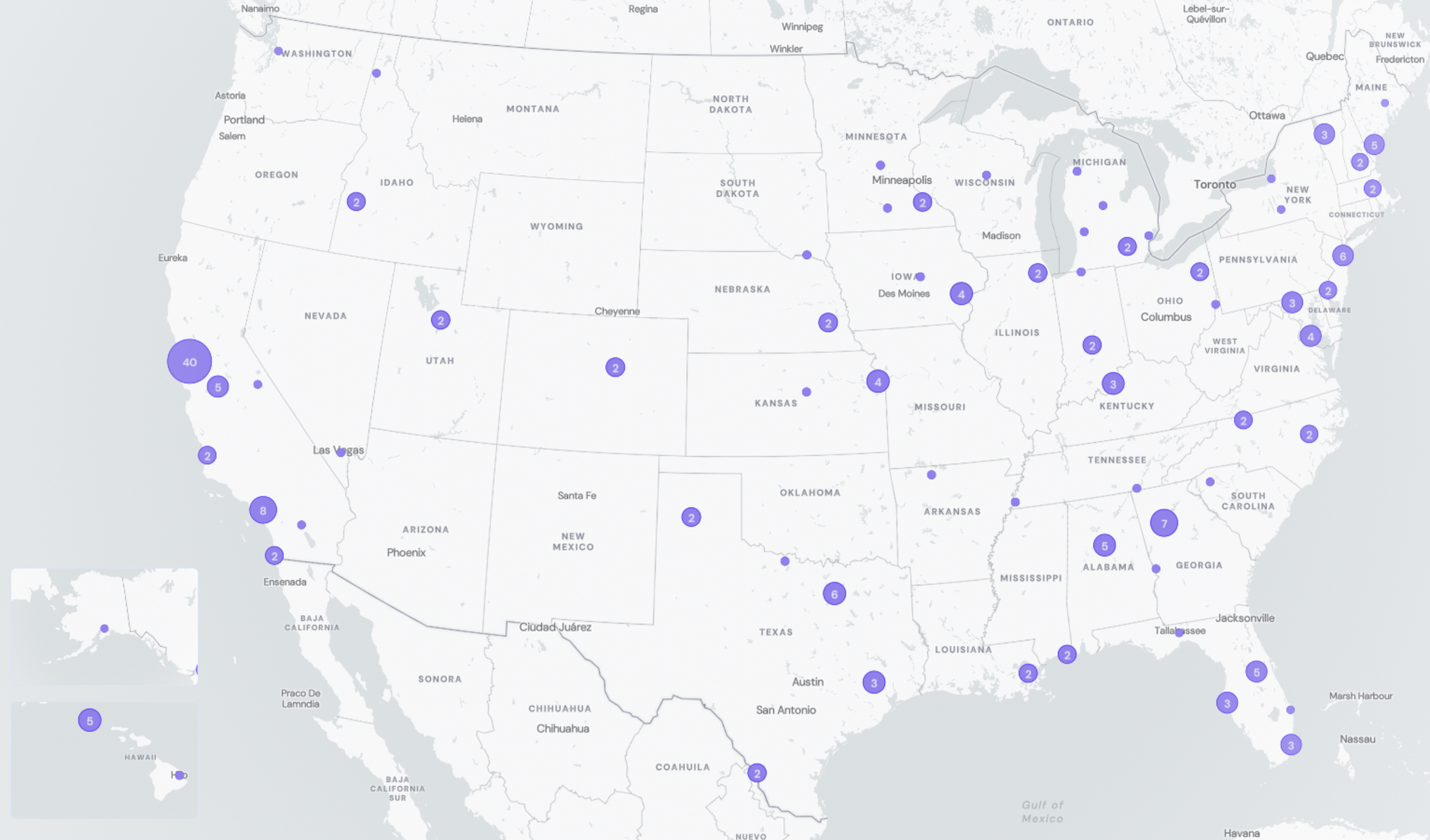
Infectious Disease Target Review
Currently monitoring a suite of Respiratory, Gastrointestinal and Outbreak Pathogens of Concern

The methods for our assays are in the public domain and links for these are provided at the end of the newsletter. Please note that due to performance issues with the Influenza A assay, we have stopped testing for Adenovirus group F in early January to accommodate the necessary changes for Influenza A.
Program Updates
WWSCAN funding is secured through Spring 2024
WastewaterSCAN currently has funding to continue monitoring until approximately June 2024. We anticipate to be able to provide an update on this within the next four weeks.
COVID-19
SARS-CoV-2 concentration in wastewater and sequencing for variants
SARS-CoV-2 N gene RNA median concentration across all sites over the last 21 days is 155,712 copies/gram. For reference, the median concentration in January 2024 was 226,648 copies/gram. Below is the population weighted average SARS-CoV-2 N gene concentrations (normalized by PMMoV) from all participating WWSCAN sites across the country over the last 365 days.
Nationally, SARS-CoV-2 is in the "High" category with aggregated measurements showing high concentrations and an upward trend over the past 21 days.

Below are the population-weighted average SARS-CoV-2 N gene concentrations (normalized by PMMoV) from sites in the Midwest US (top left panel), Northeast US (top right panel), Southern US (bottom left panel) and Western US (bottom right panel) over the last 365 days. Raw data have been omitted from the plots for clarity of presentation but are still available in the chart settings on dashboard.
The Midwest, Northeast, and Southern regions are currently in the "High" category, and the West is in the "Medium" category.
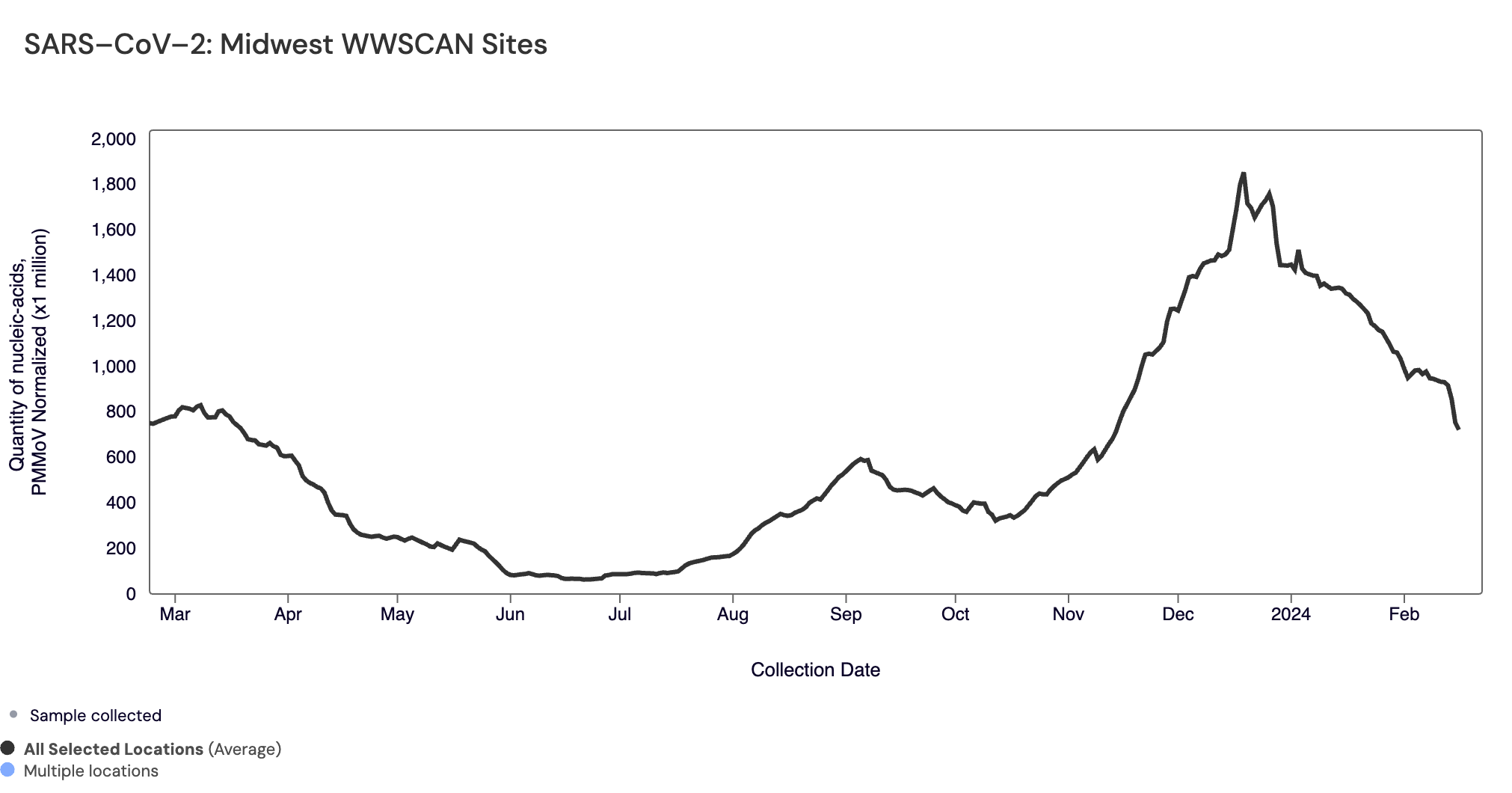
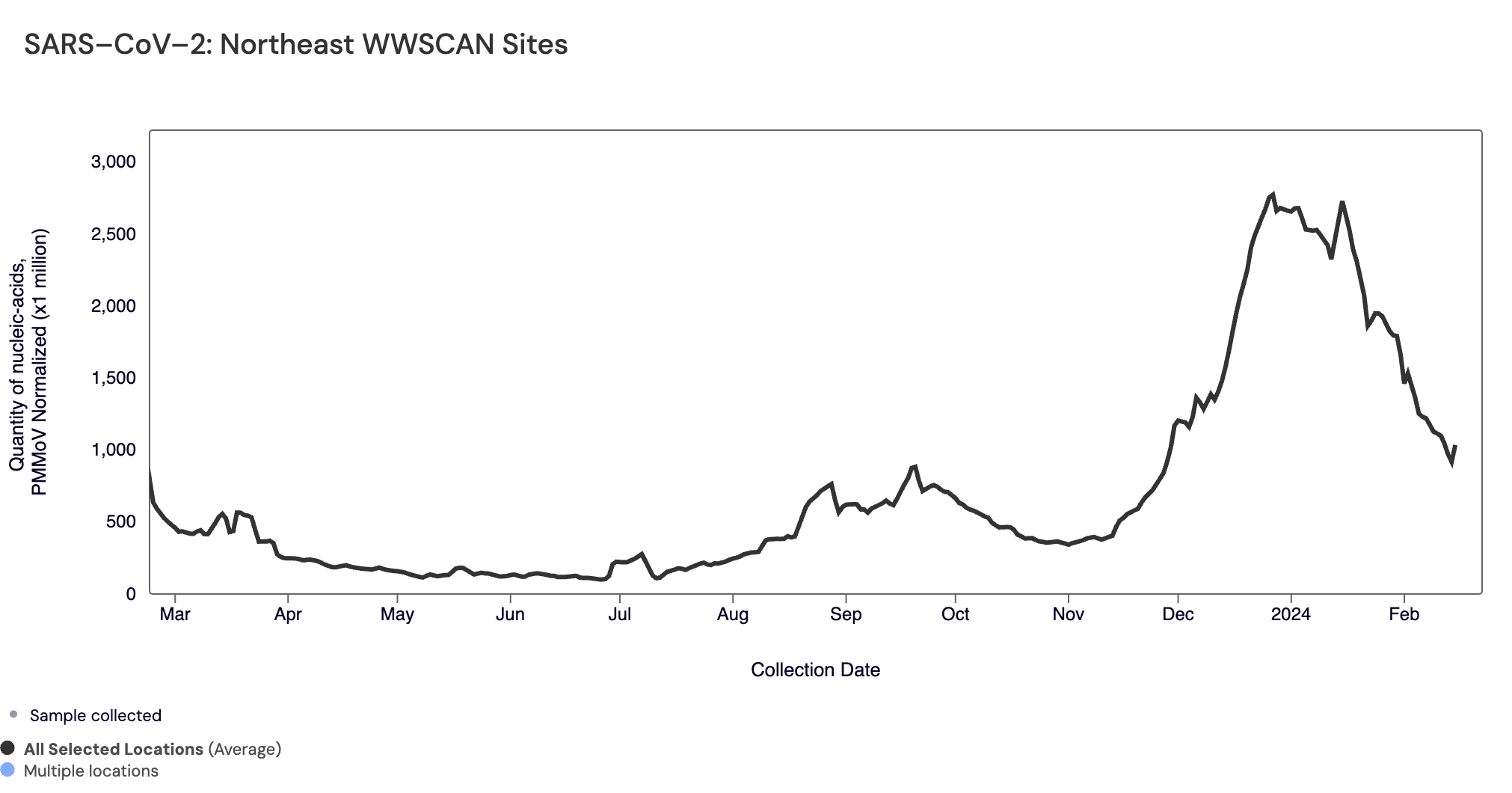
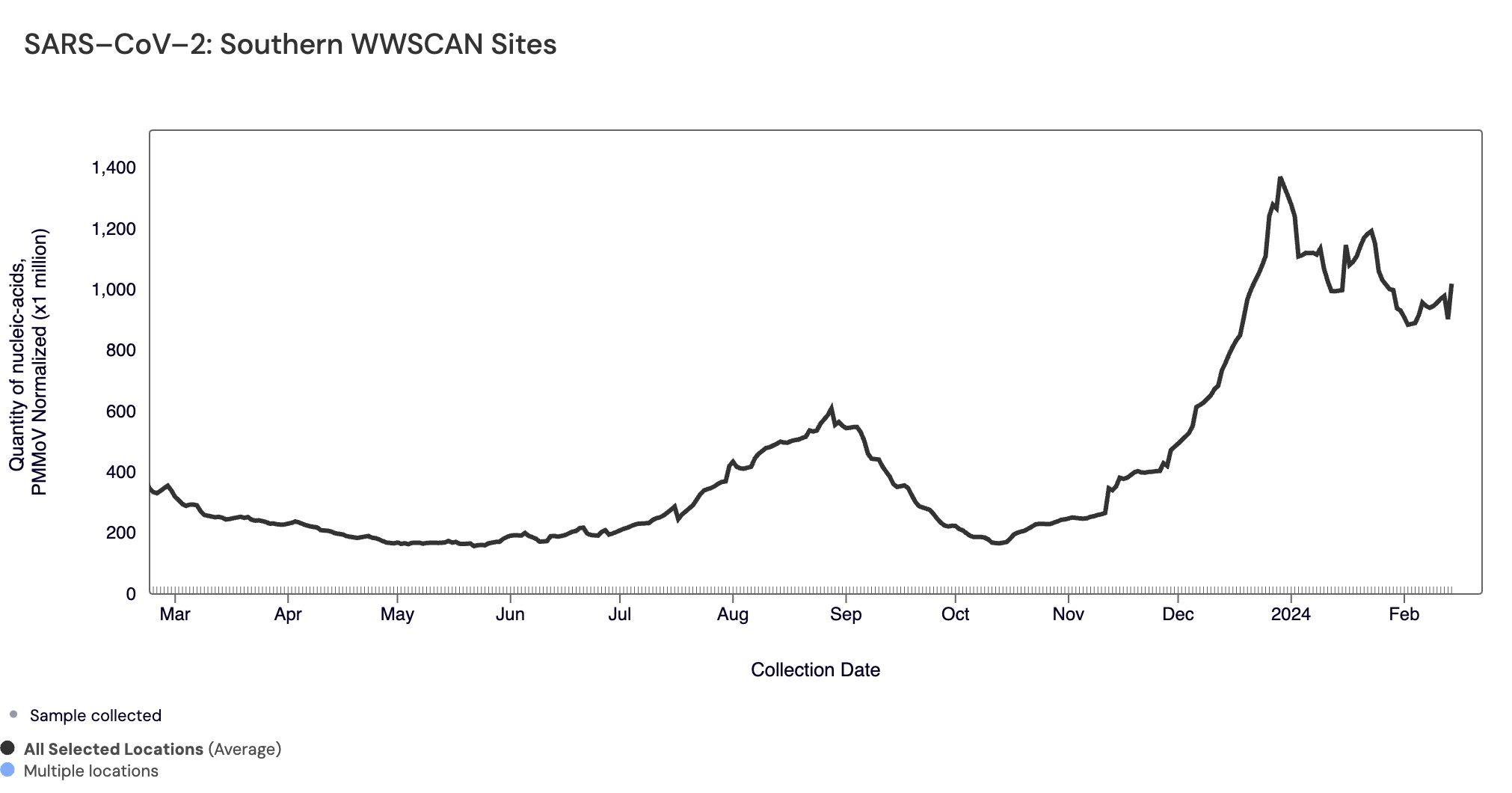
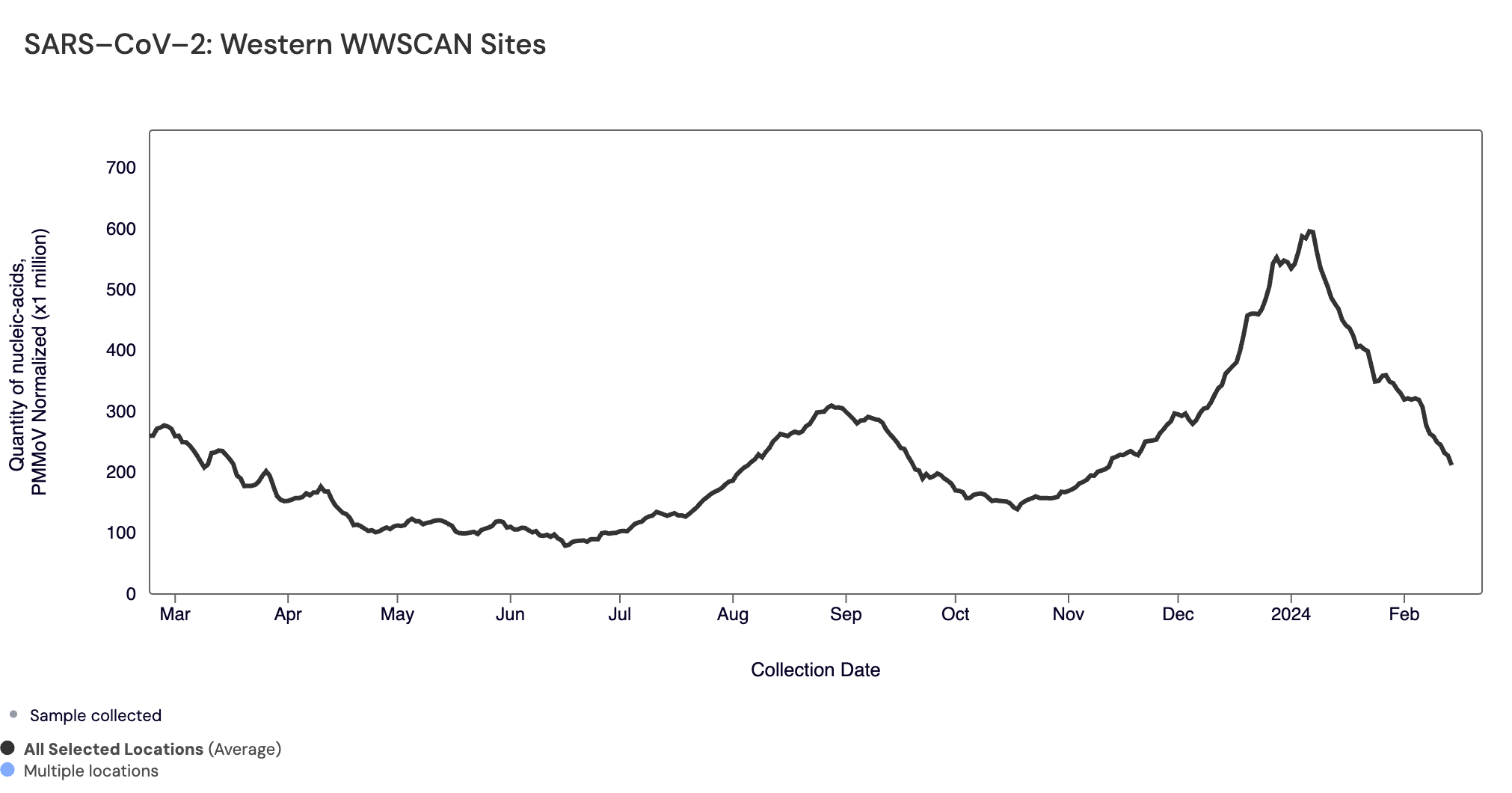
Midwest states: IA, IL, IN, KS, MI, MN, NE, OH, SD, WI. Northeast states: CT, MA, ME, NH, NJ, NY, PA, VT. Southern states: AL, AR, DE, FL, GA, KY, LA, MD, MS, NC, TN, TX, VA, WV and Washington DC. Western States: AK, CA, CO, HI, ID, NV, UT, WA.
Below are the current SARS-CoV-2 wastewater categories for all WWSCAN sites:
- 33 are in the LOW Wastewater Category
- 47 are in the MEDIUM Wastewater Category
- 81 are in the HIGH Wastewater Category
- 30 do not have enough data to calculate (Fremont, CA; Madera, CA; Marina, CA; Newark, CA; Ontario, CA; San Rafael, CA; Santa Cruz County, CA; Santa Rosa, CA; South San Diego, CA; Union City, CA; West Railroad, San Rafael, CA; South Miami, FL; Columbus, GA; Hilo, HI; Honouliuli, HI; Sand Island, HI; Wahiawa, HI; Waianae, HI; Louisville, KY; York, ME; Millbury, MA; Jackson, MI; Gautier, MS; Pascagoula Moss Point, MS; Newark, NJ; Youngstown, OH; Chester, PA; Harrisburg, PA; Memphis, TN; Southside Dallas, TX)

SARS-CoV-2 Wastewater Categories. This map includes sample collection data through February 21, 2024. Each dot represents a single site and the four US Census regions are outlined in gray. Midwest Region includes: IA, IL, IN, KS, MI, MN, NE, OH, SD, WI. Northeast Region includes: CT, MA, ME, NH, NJ, NY, PA, VT. Southern Region includes: AL, AR, DE, FL, GA, KY, LA, MD, MS, NC, TN, TX, VA, WV and Washington DC. Western Region includes: AK, CA, CO, HI, ID, NV, UT, WA.
Sequencing of SARS-CoV-2 from wastewater is available for a select number of individual sites. The sequencing protocol is available on protocol.io. The plots below show the relative proportions of different variants inferred from sequencing the entire genome of SARS-CoV-2. Results are based on sequencing of 2 samples per week, combined to provide a weekly value.
Sequencing data is also available in aggregate across all sites in WWSCAN with sequencing data. That plot is shown below and also suggests that JN.1 is the most abundant variant across all sites (92.3%).

The plots show one site each from the Midwest (top left panel), Northeast (top right panel), South (bottom left panel) and West (bottom right panel). Data from the week of February 10th, 2024 illustrates that JN.1 (bright red) made up the largest proportion of the lineages detected at detected at Ann Arbor, MI (76.6%), Portland, ME (100%), Bessemer, AL (65.4%) and Las Vegas,NV (100%).

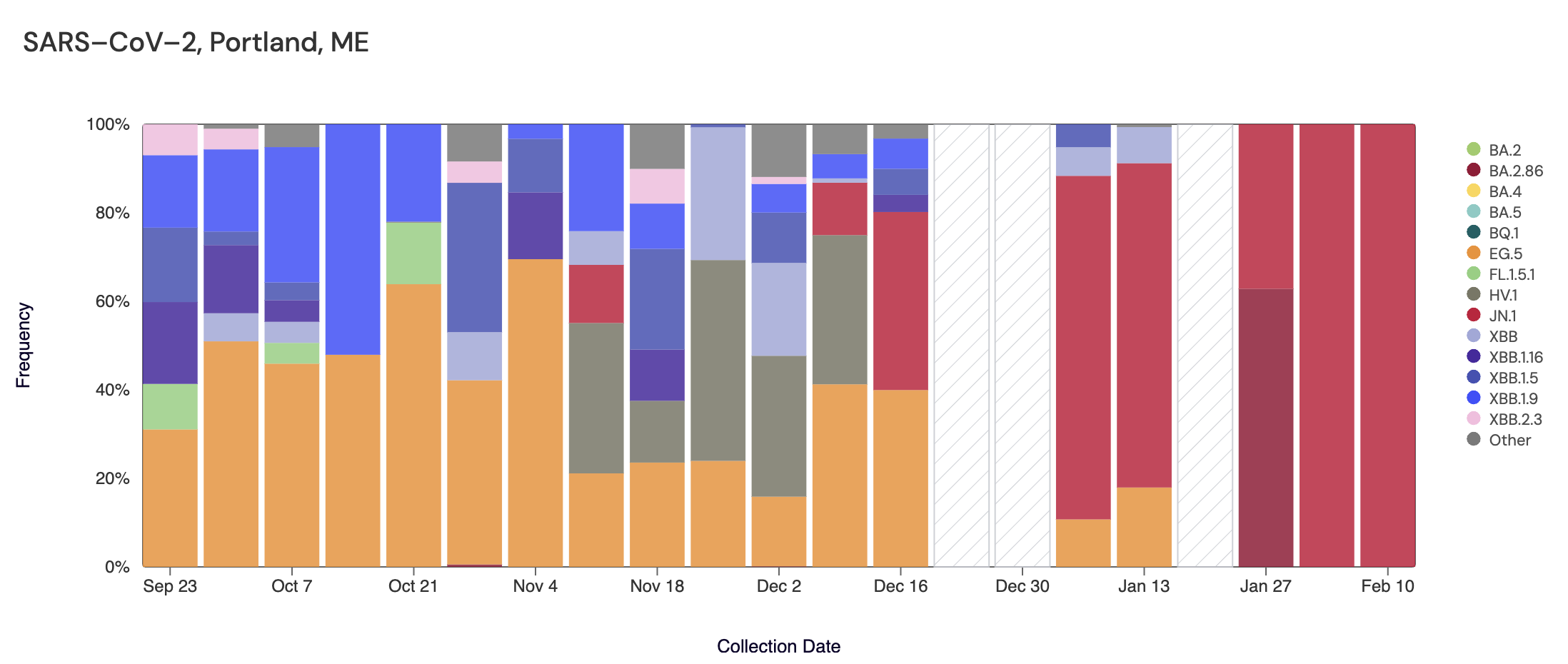
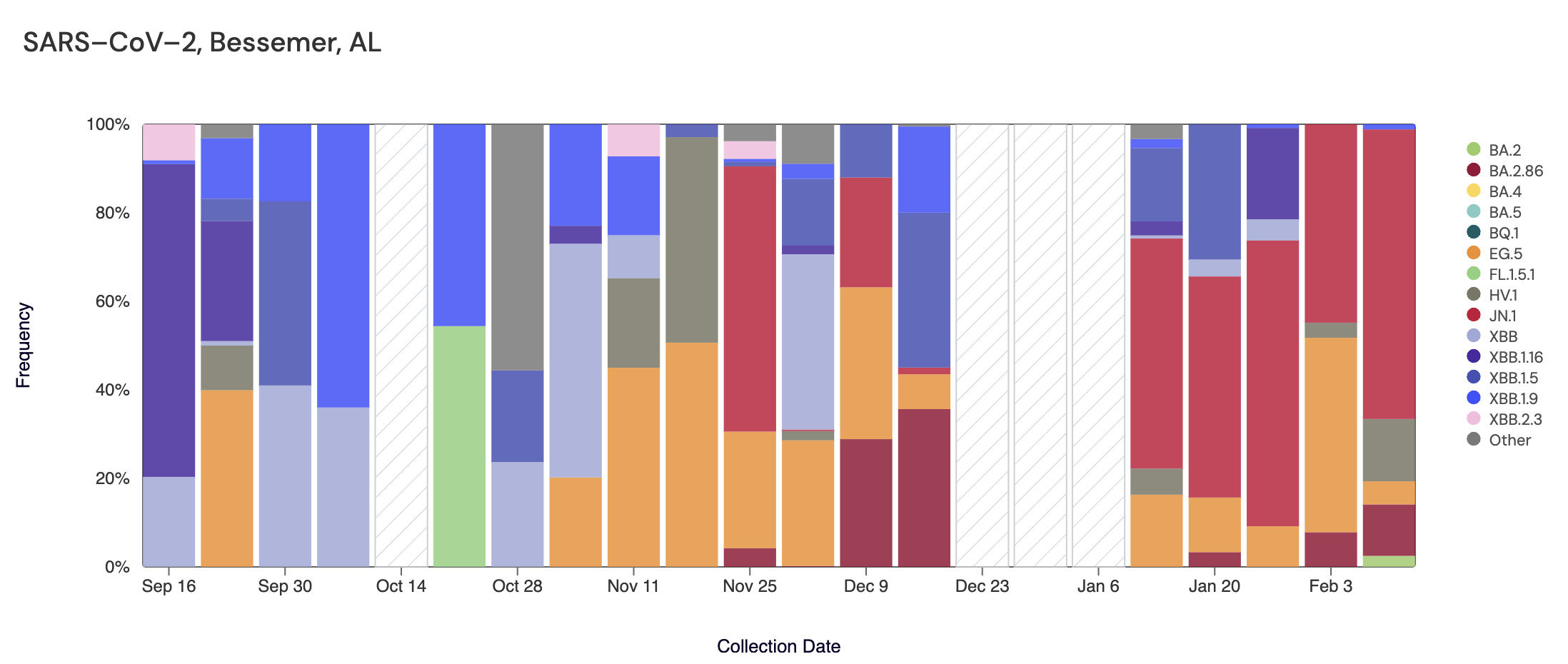
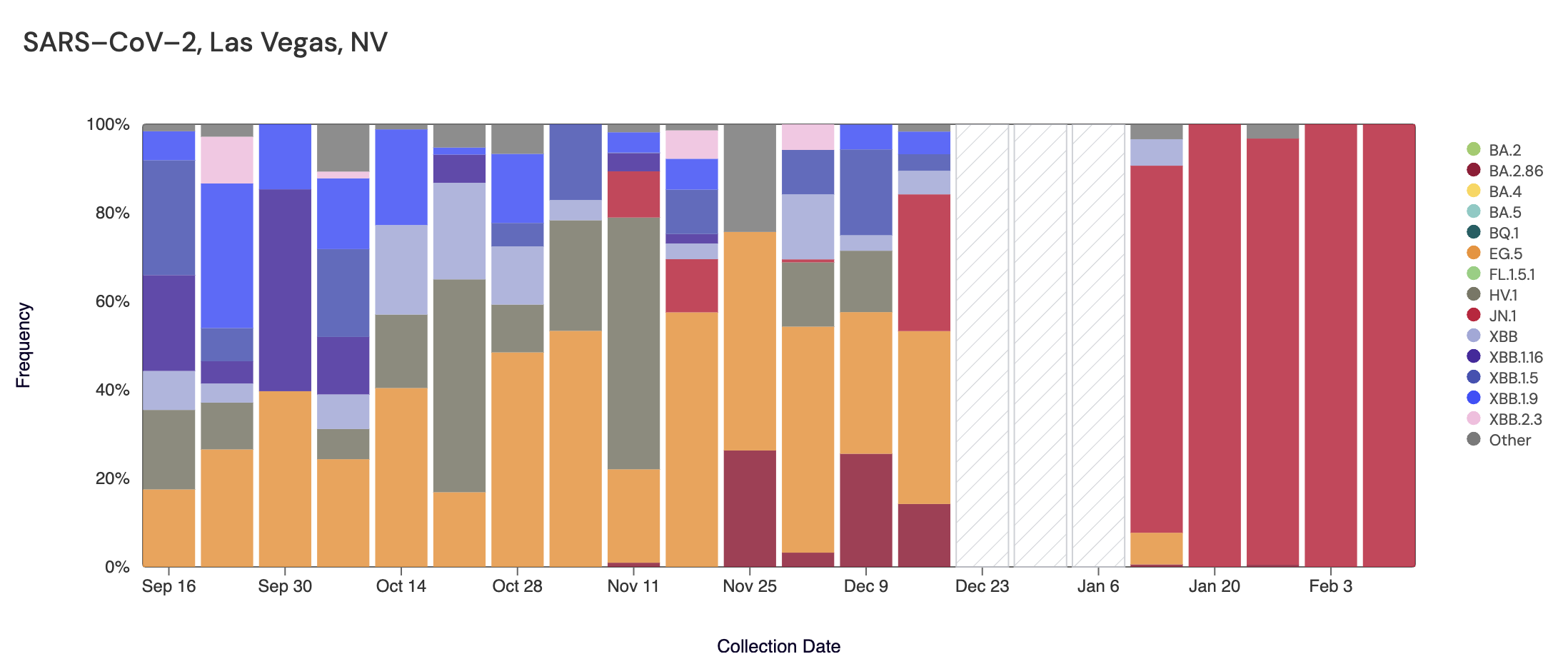
Plots show 1 site from the Midwest US (top left panel), Northeast US (top right panel), Southern US (bottom left panel) and Western US (bottom right panel)
Other Respiratory Pathogens
Influenza A & B, Respiratory Syncytial Virus, Human metapneumovirus, Human Parainfluenza & EV-D68
Influenza A (IAV) RNA A couple of weeks ago, we identified a technical issue with the IAV assay. All of the impacted data (1 Oct 2023 to approximately 11 Jan 2024) were removed from the website. We are now analyzing samples for IAV RNA using a probe containing a different, better performing fluorescent molecule. We have retrospectively rerun a subset of samples between 1 Oct 2023 and early Jan 2024 and have added those results to the site.
IAV RNA median concentration across all sites over the last 21 days is 16,653 copies/gram. For reference, the median concentration in January 2024 was 25,276 copies/gram. Below is the population weighted average IAV concentrations (normalized by PMMoV) from all participating WWSCAN sites across the country over the last 365 days.
Nationally, IAV is in the "High" category with aggregated measurements showing high concentrations but no trend over the past 21 days.

Below are the population-weighted average IAV RNA concentrations (normalized by PMMoV) from sites in the Midwest US (top left panel), Northeast US (top right panel), Southern US (bottom left panel) and Western US (bottom right panel) over the last 365 days.
The plots below show relatively high concentrations across all US regions, with decreasing trends in the Midwest, South and West regions over the past 21 days.

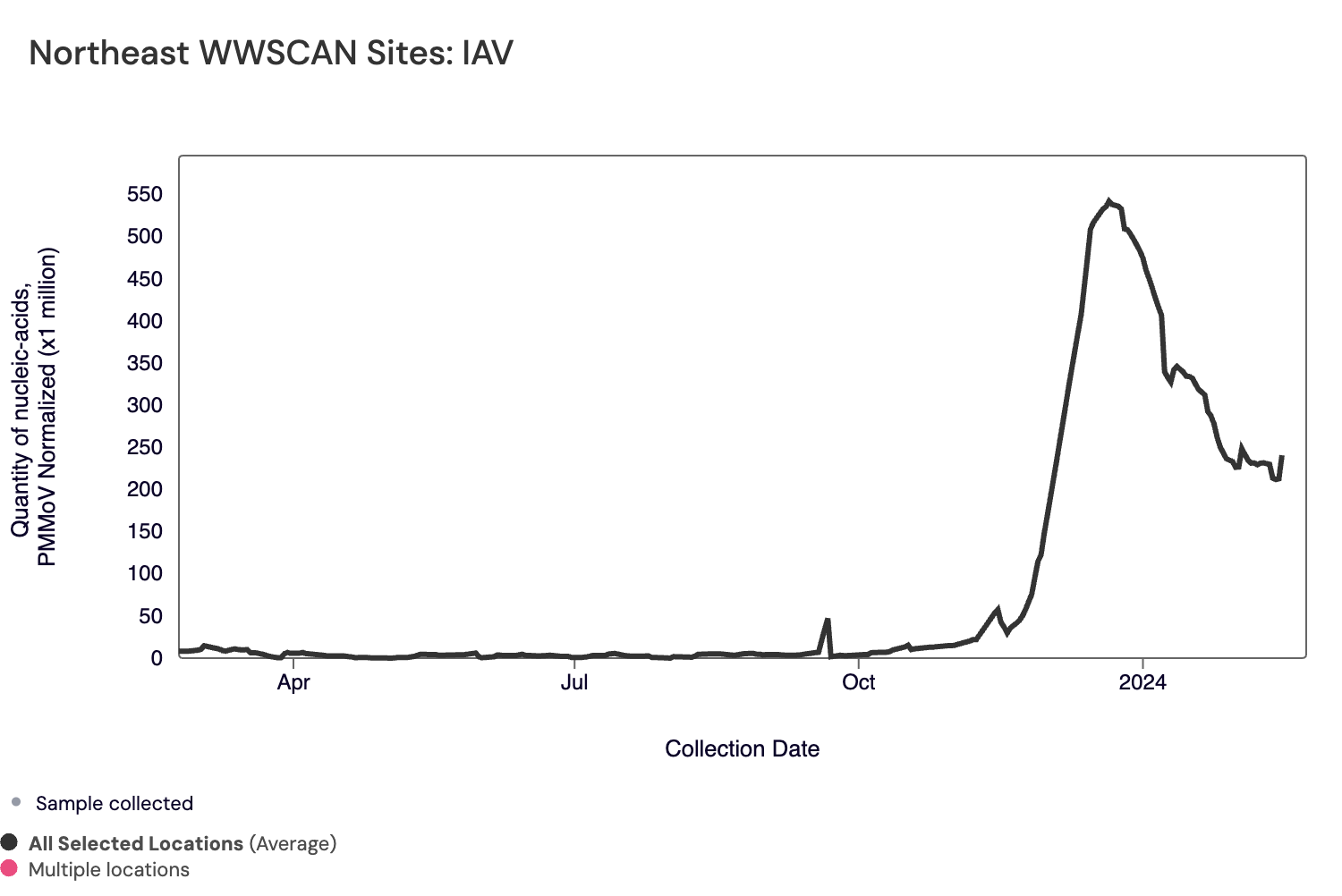
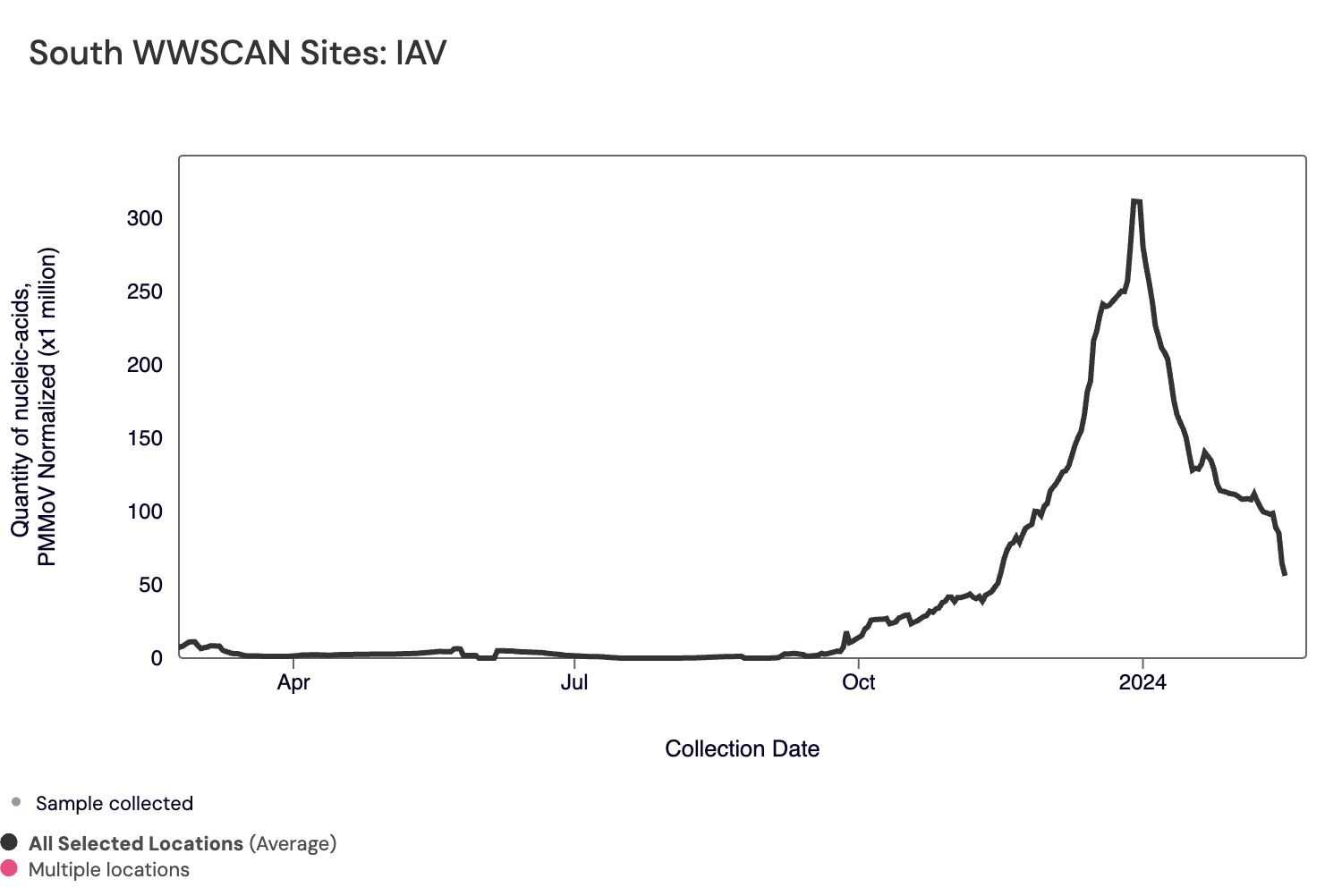
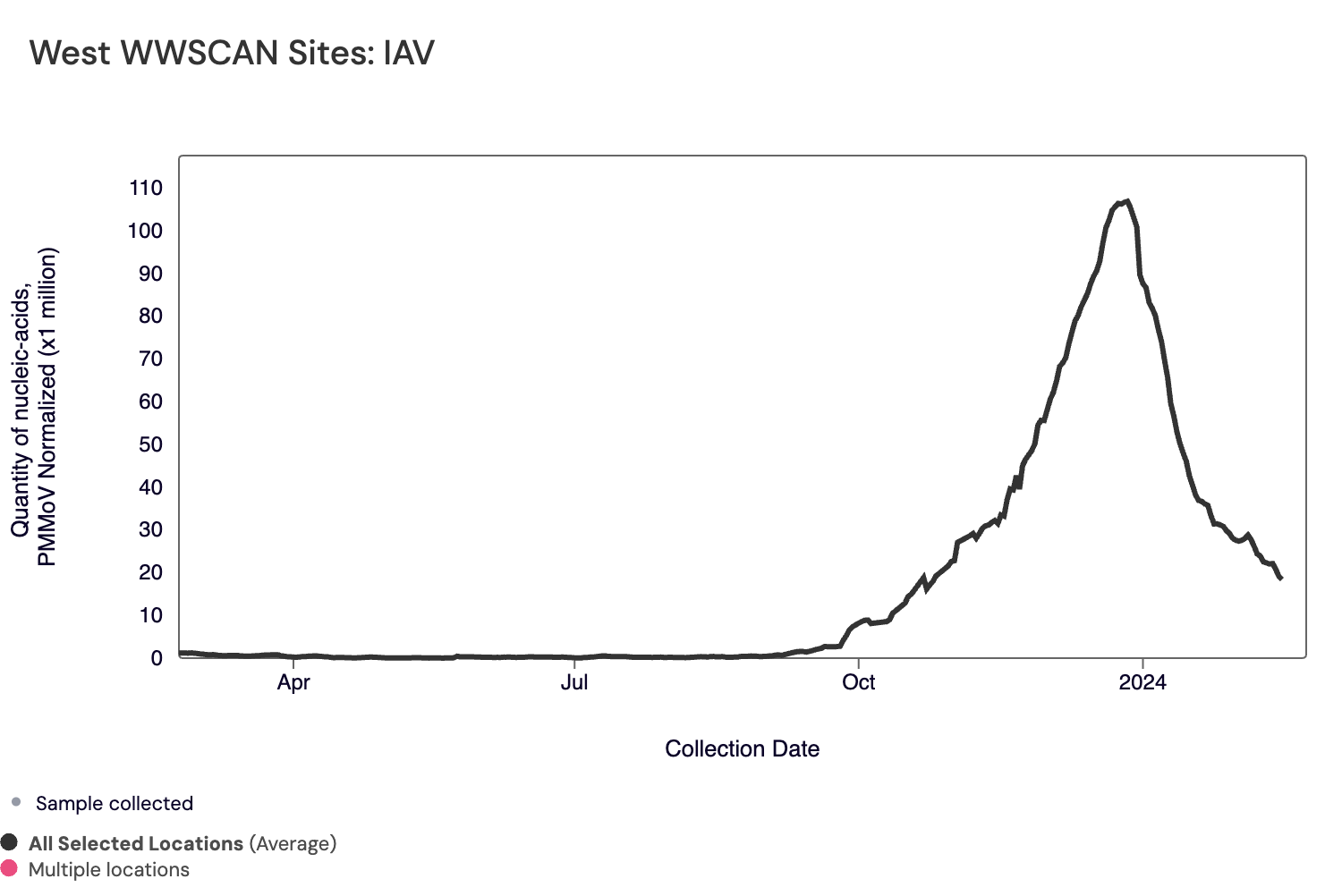
Midwest states: IA, IL, IN, KS, MI, MN, NE, OH, SD, WI. Northeast states: CT, MA, ME, NH, NJ, NY, PA, VT. Southern states: AL, AR, DE, FL, GA, KY, LA, MD, MS, NC, TN, TX, VA, WV and Washington DC. Western States: AK, CA, CO, HI, ID, NV, UT, WA.
Below are the current Influenza A wastewater categories for all WWSCAN sites, with 75% of sites showing wastewater onset for IAV:
- 16 are in the LOW Wastewater Category
- 0 are in the MEDIUM Wastewater Category
- 145 are in the HIGH Wastewater Category
- 30 do not have enough data to calculate (Fremont, CA; Madera, CA; Marina, CA; Newark, CA; Ontario, CA; San Rafael, CA; Santa Cruz County, CA; Santa Rosa, CA; South San Diego, CA; Union City, CA; West Railroad, San Rafael, CA; South Miami, FL; Columbus, GA; Hilo, HI; Honouliuli, HI; Sand Island, HI; Wahiawa, HI; Waianae, HI; Louisville, KY; York, ME; Millbury, MA; Jackson, MI; Gautier, MS; Pascagoula Moss Point, MS; Newark, NJ; Youngstown, OH; Chester, PA; Harrisburg, PA; Memphis, TN; Southside Dallas, TX)
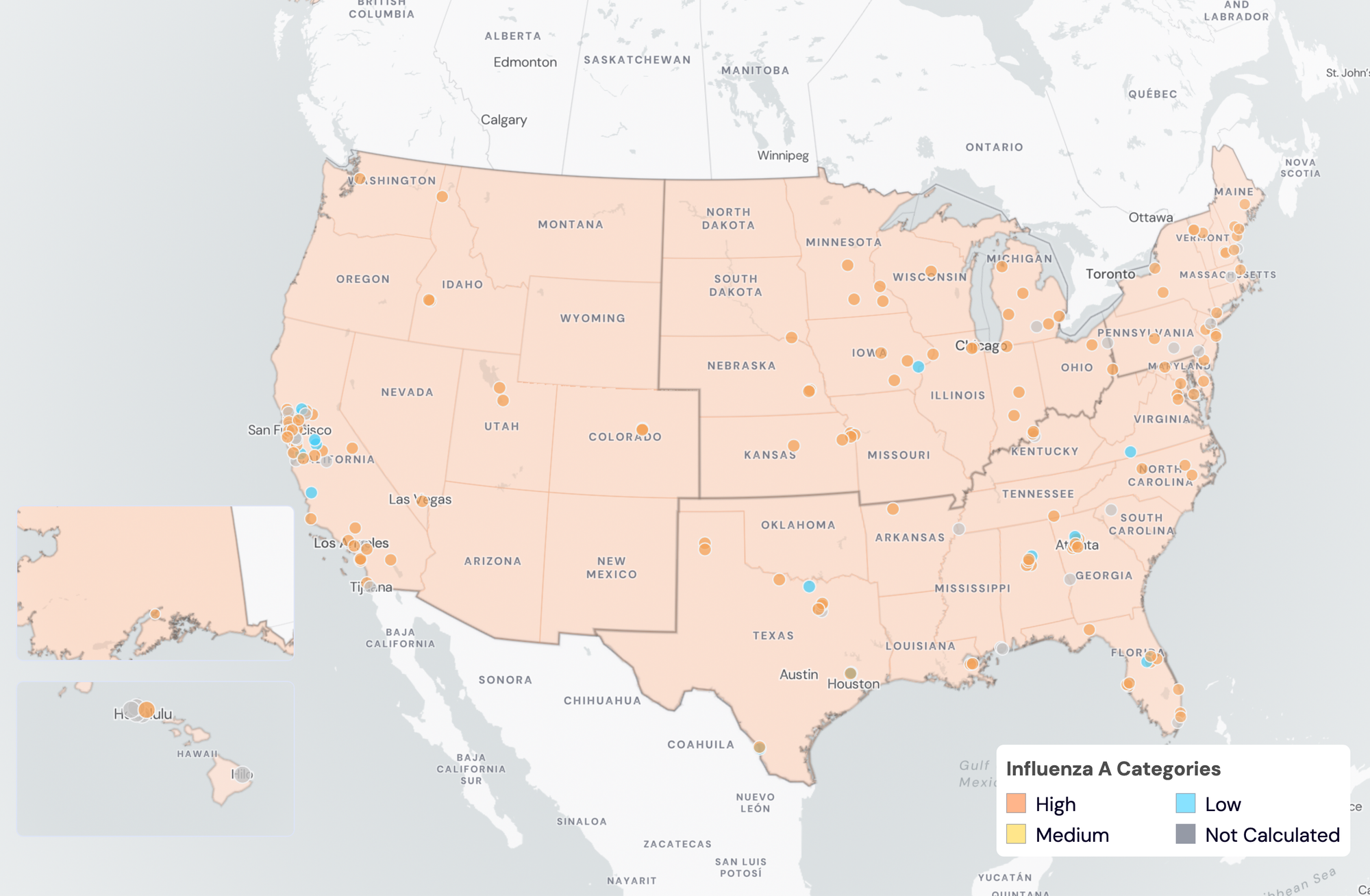
IAV Wastewater Categories. This map includes sample collection data through February 21, 2024. Each dot represents a single site and the four US Census regions are outlined in gray. Midwest Region includes: IA, IL, IN, KS, MI, MN, NE, OH, SD, WI. Northeast Region includes: CT, MA, ME, NH, NJ, NY, PA, VT. Southern Region includes: AL, AR, DE, FL, GA, KY, LA, MD, MS, NC, TN, TX, VA, WV and Washington DC. Western Region includes: AK, CA, CO, HI, ID, NV, UT, WA.
Influenza B (IBV) RNA has been detected in 1,271 out of 1,334 samples during the past 21 days (~95% detection rate). IBV RNA median concentration across all sites over the last 21 days is 12,760 copies/gram. For reference, the median concentration in January 2024 was 5,650 copies/gram. Below is the population-weighted average IBV RNA concentrations (normalized by PMMoV) from all participating WWSCAN sites across the country over the last 365 days.
Nationally, influenza B is in the "High" category with >50% of sites showing onset of IBV in wastewater and aggregated measurements showing high concentrations with an upward trend over the last 21 days.

Below are the current Influenza B wastewater categories for all WWSCAN sites, with 73% of sites showing wastewater onset for IBV:
- 20 are in the LOW Wastewater Category
- 0 are in the MEDIUM Wastewater Category
- 141 are in the HIGH Wastewater Category
- 30 do not have enough data to calculate (Fremont, CA; Madera, CA; Marina, CA; Newark, CA; Ontario, CA; San Rafael, CA; Santa Cruz County, CA; Santa Rosa, CA; South San Diego, CA; Union City, CA; West Railroad, San Rafael, CA; South Miami, FL; Columbus, GA; Hilo, HI; Honouliuli, HI; Sand Island, HI; Wahiawa, HI; Waianae, HI; Louisville, KY; York, ME; Millbury, MA; Jackson, MI; Gautier, MS; Pascagoula Moss Point, MS; Newark, NJ; Youngstown, OH; Chester, PA; Harrisburg, PA; Memphis, TN; Southside Dallas, TX)
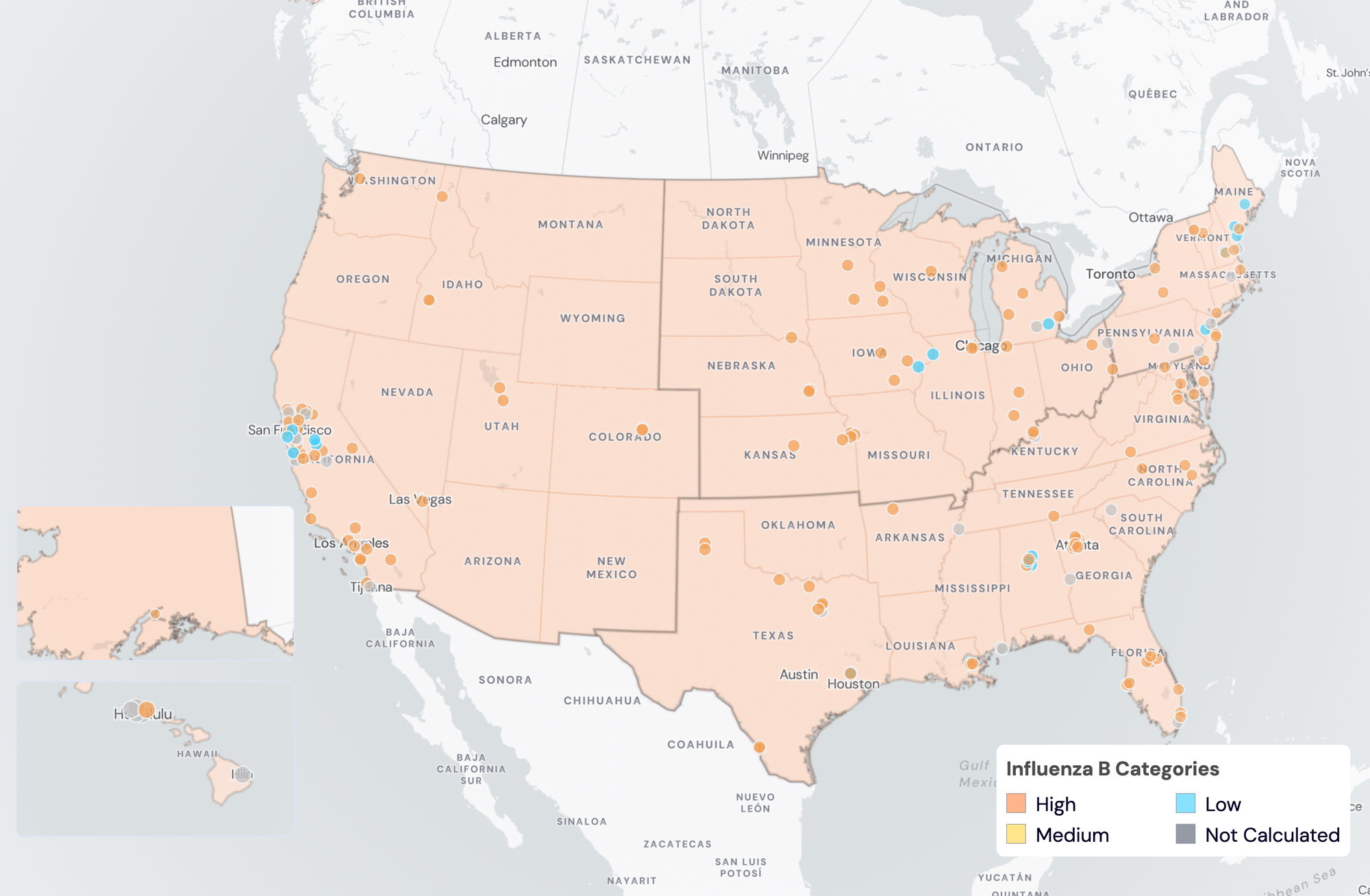
IBV Wastewater Categories. This map includes sample collection data through February 21, 2024. Each dot represents a single site and the four US Census regions are outlined in gray. Midwest Region includes: IA, IL, IN, KS, MI, MN, NE, OH, SD, WI. Northeast Region includes: CT, MA, ME, NH, NJ, NY, PA, VT. Southern Region includes: AL, AR, DE, FL, GA, KY, LA, MD, MS, NC, TN, TX, VA, WV and Washington DC. Western Region includes: AK, CA, CO, HI, ID, NV, UT, WA.
Respiratory syncytial virus (RSV) RSV RNA median concentration across all sites over the last 21 days is 10,839 copies/gram. For reference, the median concentration in January 2024 was 20,013 copies/gram. There have been 1,091 positive samples out of 1,334 samples during the past 21 days (~81% detection rate). Below are the RSV RNA concentrations (normalized by PMMoV) from all participating WWSCAN sites across the country over the last 365 days shown as the population-weighted average.
Nationally, RSV is in the "High" category, with >50% of sites showing onset of RSV in wastewater and aggregated measurements showing high concentrations with a downward trend over the last 21 days.

Below are the population-weighted average RSV RNA concentrations (normalized by PMMoV) from sites in the Midwest US (top left panel), Northeast US (top right panel), Southern US (bottom left panel) and Western US (bottom right panel) over the last 365 days.
The plots below show relatively high concentrations across all US regions. The South had a statistically significant downward trend over the past 21 days.

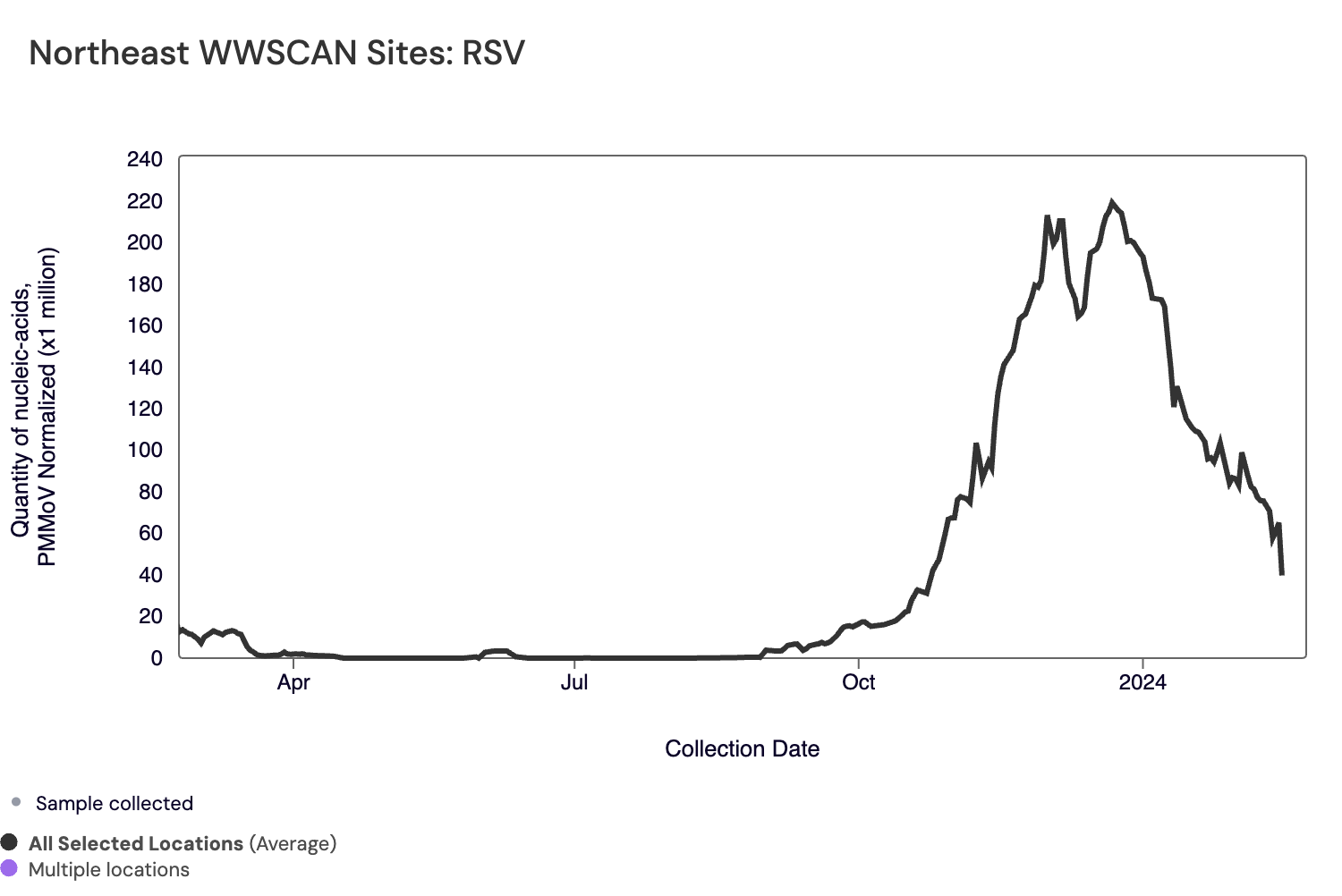

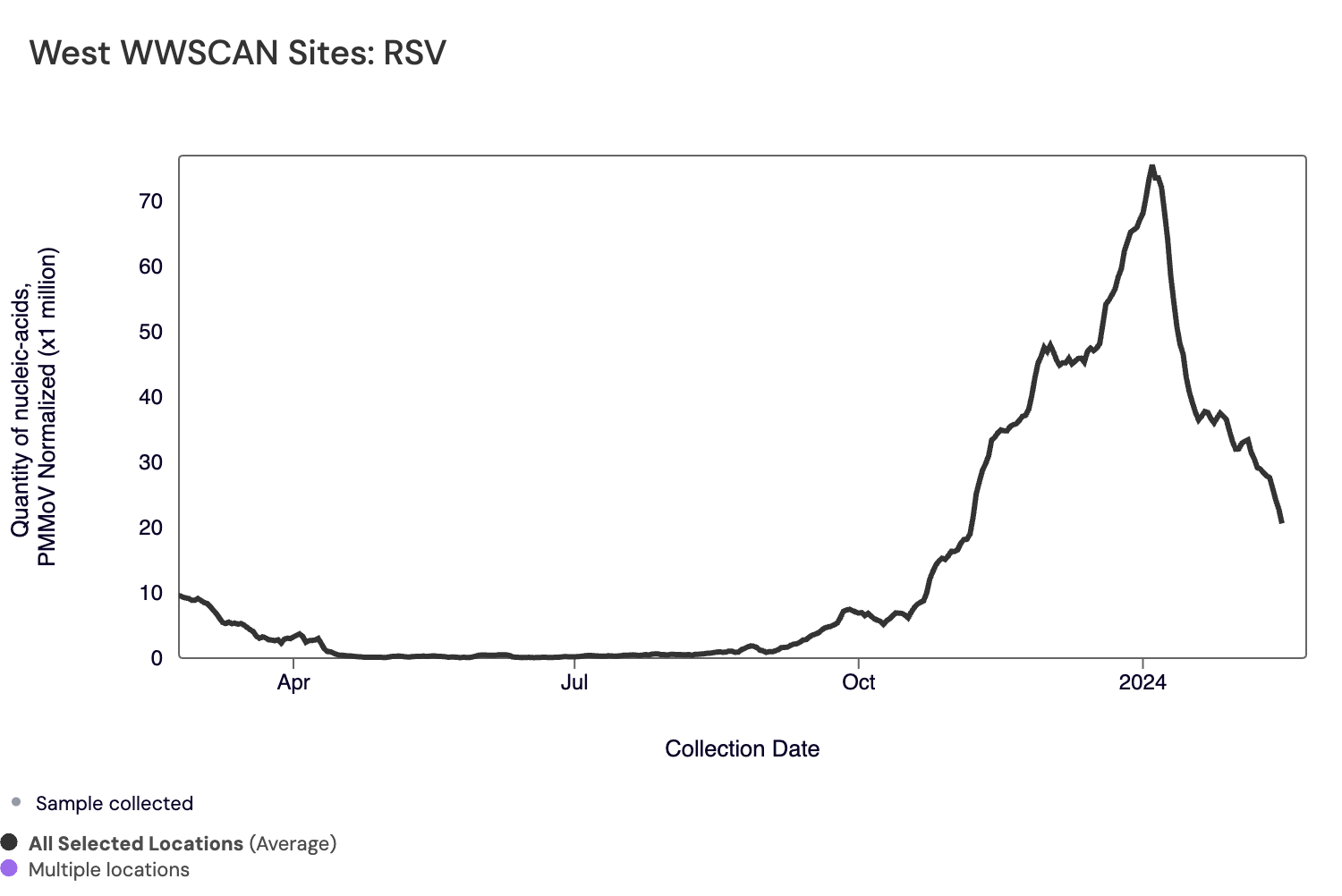
Midwest states: IA, IL, IN, KS, MI, MN, NE, OH, SD, WI. Northeast states: CT, MA, ME, NH, NJ, NY, PA, VT. Southern states: AL, AR, DE, FL, GA, KY, LA, MD, MS, NC, TN, TX, VA, WV and Washington DC. Western States: AK, CA, CO, HI, ID, NV, UT, WA.
Below are the current RSV wastewater categories for all WWSCAN sites, with 68% of sites showing wastewater onset for RSV:
- 41 are in the LOW Wastewater Category
- 22 are in the MEDIUM Wastewater Category
- 98 are in the HIGH Wastewater Category
- 30 do not have enough data to calculate (Fremont, CA; Madera, CA; Marina, CA; Newark, CA; Ontario, CA; San Rafael, CA; Santa Cruz County, CA; Santa Rosa, CA; South San Diego, CA; Union City, CA; West Railroad, San Rafael, CA; South Miami, FL; Columbus, GA; Hilo, HI; Honouliuli, HI; Sand Island, HI; Wahiawa, HI; Waianae, HI; Louisville, KY; York, ME; Millbury, MA; Jackson, MI; Gautier, MS; Pascagoula Moss Point, MS; Newark, NJ; Youngstown, OH; Chester, PA; Harrisburg, PA; Memphis, TN; Southside Dallas, TX)
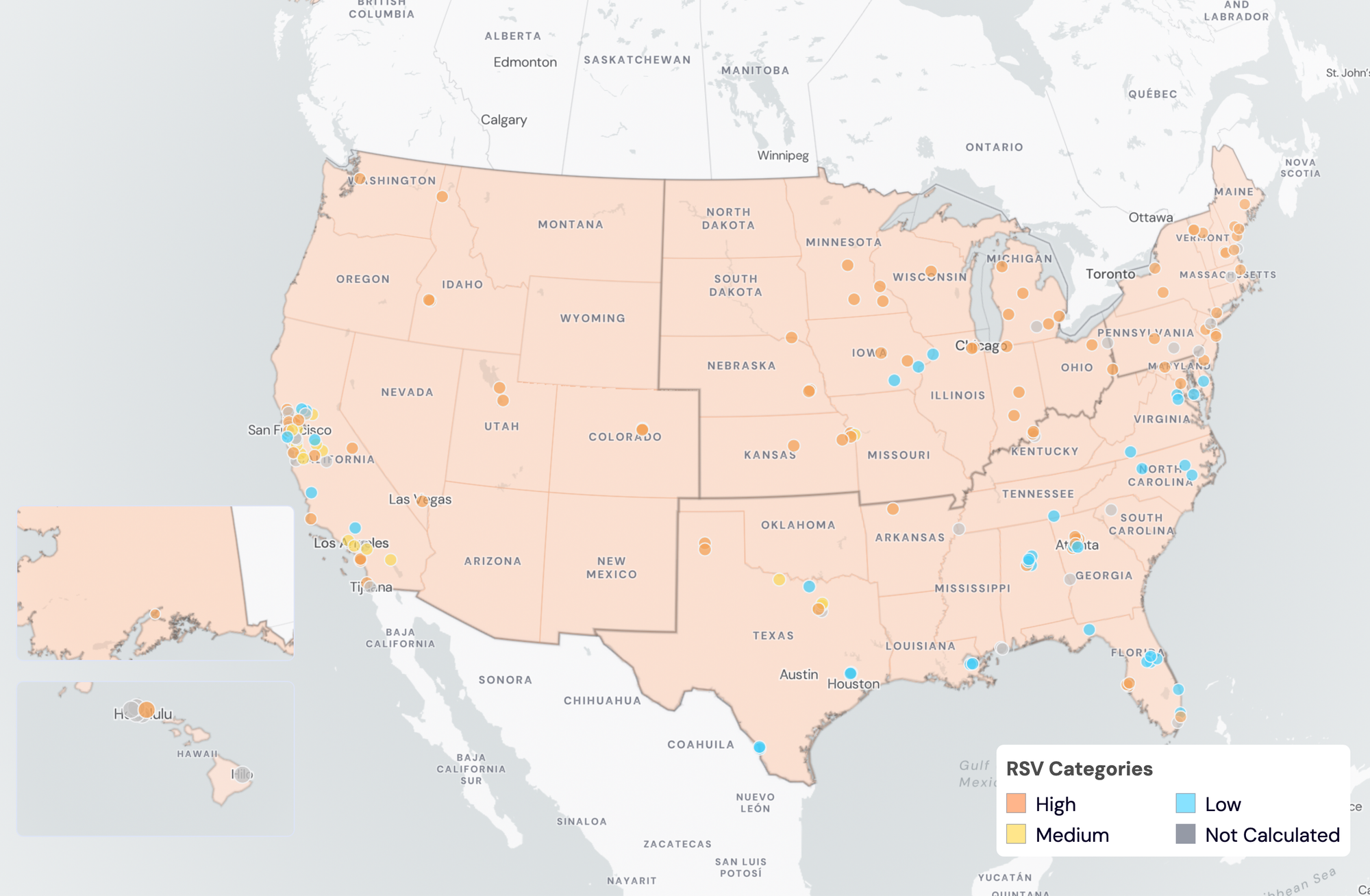
RSV Wastewater Categories. This map includes sample collection data through February 21, 2024. Each dot represents a single site and the four US Census regions are outlined in gray. Midwest Region includes: IA, IL, IN, KS, MI, MN, NE, OH, SD, WI. Northeast Region includes: CT, MA, ME, NH, NJ, NY, PA, VT. Southern Region includes: AL, AR, DE, FL, GA, KY, LA, MD, MS, NC, TN, TX, VA, WV and Washington DC. Western Region includes: AK, CA, CO, HI, ID, NV, UT, WA.
HMPV (human metapneumovirus) RNA median concentrations across all sites over the last 21 days are below the lower detection limit of the assay. There have been 672 positive samples out of 1,334 samples during the past 21 days (~50% detection rate). Below is the population weighted average HMPV RNA concentrations (normalized by PMMoV) from all participating WWSCAN sites across the country over the last 365 days.
Nationally, HMPV is in the "Low" category. Concentrations are lower compared to around this time last year, but are starting to show a slight increase.

Below are the population-weighted average HMPV RNA concentrations (normalized by PMMoV) from sites in the Midwest US (top left panel), Northeast US (top right panel), Southern US (bottom left panel) and Western US (bottom right panel) since we started monitoring HMPV late December 2022.
All regions are in the "Low" category.
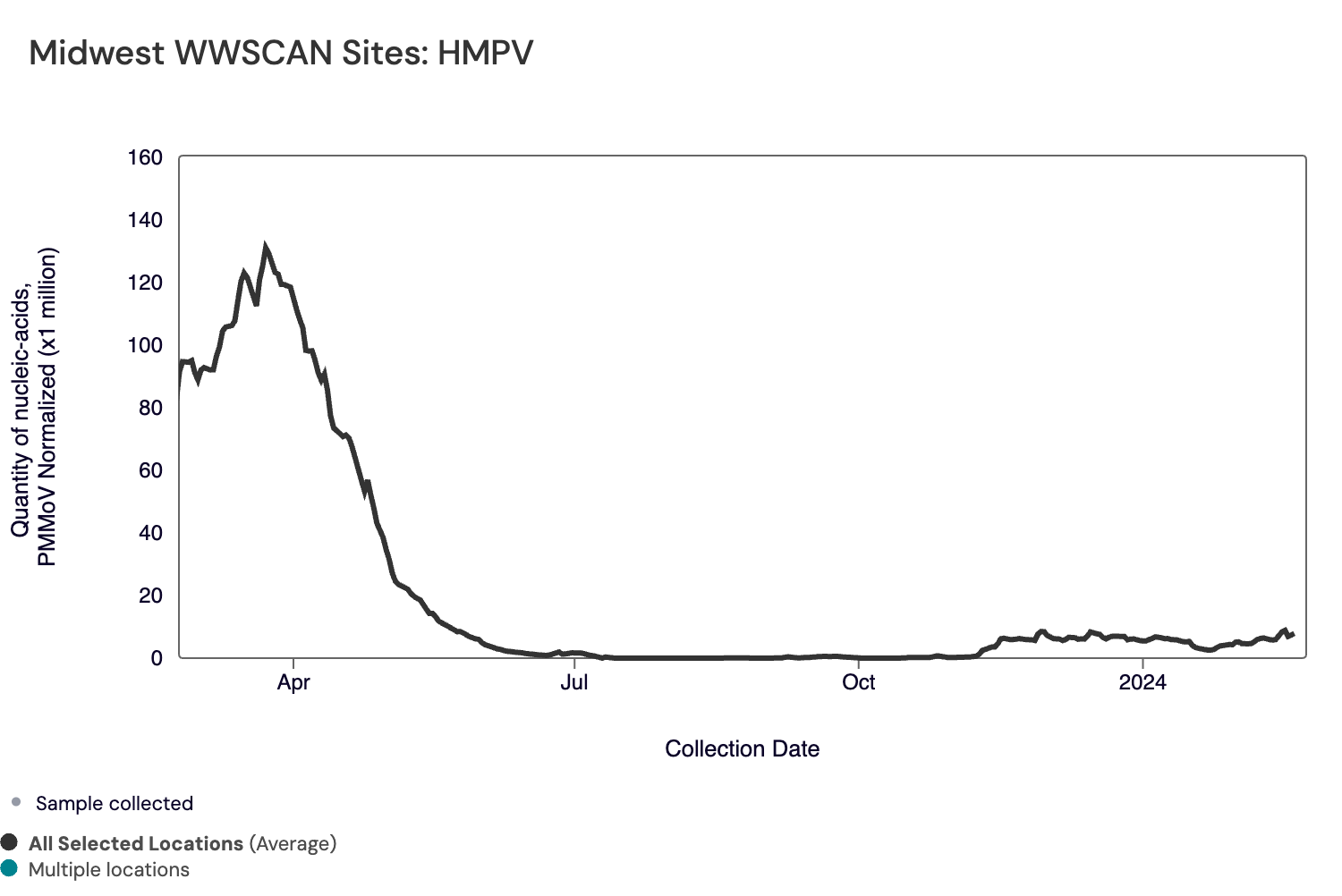



Midwest states: IA, IL, IN, KS, MI, MN, NE, OH, SD, WI. Northeast states: CT, MA, ME, NH, NJ, NY, PA, VT. Southern states: AL, AR, DE, FL, GA, KY, LA, MD, MS, NC, TN, TX, VA, WV and Washington DC. Western States: AK, CA, CO, HI, ID, NV, UT, WA.
Below are the current HMPV wastewater categories for all WWSCAN sites, with only 17% of sites showing wastewater onset for HMPV:
- 129 are in the LOW Wastewater Category
- 0 is in the MEDIUM Wastewater Category
- 32 are in the HIGH Wastewater Category
- 30 do not have enough data to calculate (Fremont, CA; Madera, CA; Marina, CA; Newark, CA; Ontario, CA; San Rafael, CA; Santa Cruz County, CA; Santa Rosa, CA; South San Diego, CA; Union City, CA; West Railroad, San Rafael, CA; South Miami, FL; Columbus, GA; Hilo, HI; Honouliuli, HI; Sand Island, HI; Wahiawa, HI; Waianae, HI; Louisville, KY; York, ME; Millbury, MA; Jackson, MI; Gautier, MS; Pascagoula Moss Point, MS; Newark, NJ; Youngstown, OH; Chester, PA; Harrisburg, PA; Memphis, TN; Southside Dallas, TX)
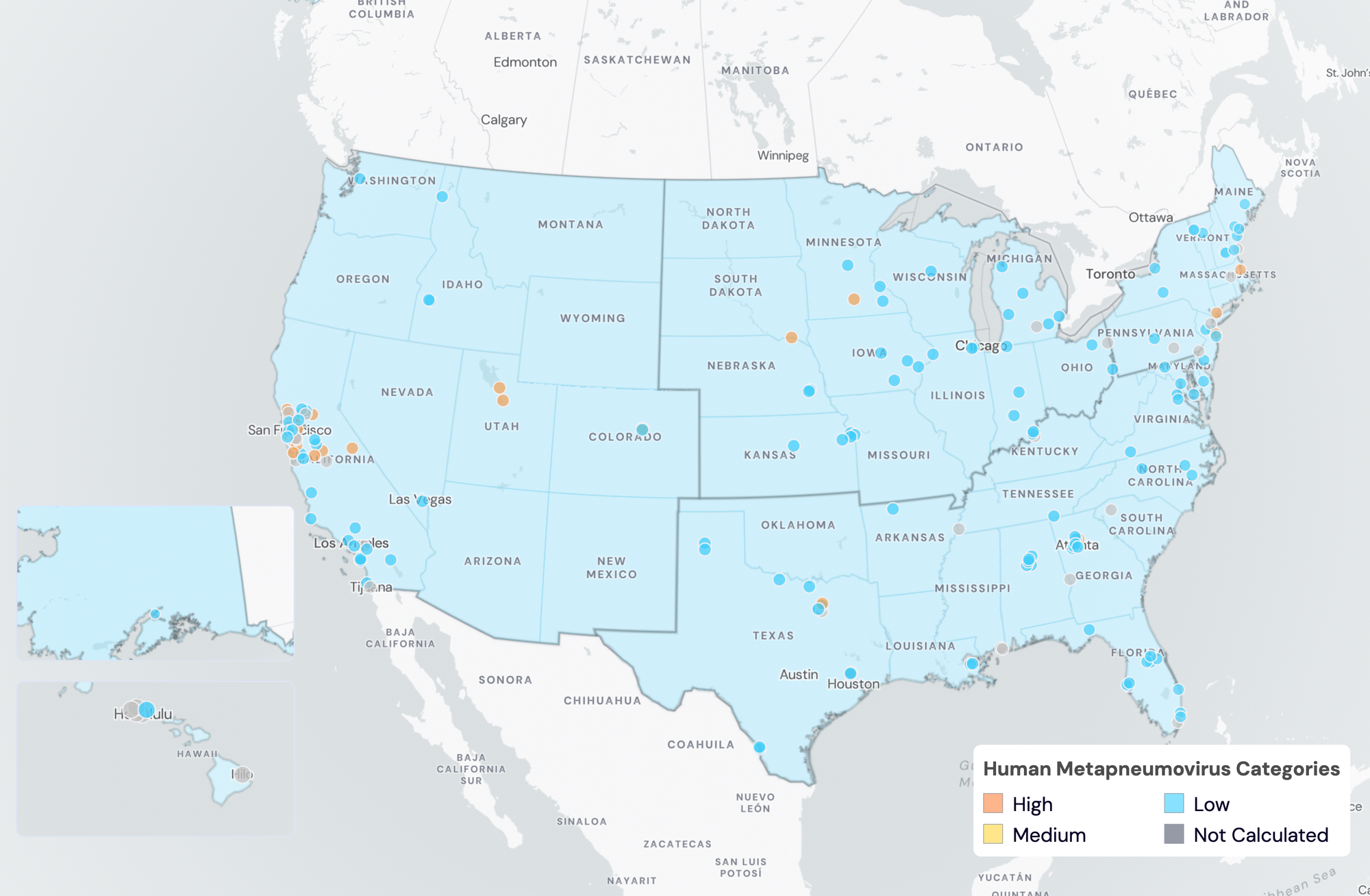
HMPV Wastewater Categories. This map includes sample collection data through February 21, 2024. Each dot represents a single site and the four US Census regions are outlined in gray. Midwest Region includes: IA, IL, IN, KS, MI, MN, NE, OH, SD, WI. Northeast Region includes: CT, MA, ME, NH, NJ, NY, PA, VT. Southern Region includes: AL, AR, DE, FL, GA, KY, LA, MD, MS, NC, TN, TX, VA, WV and Washington DC. Western Region includes: AK, CA, CO, HI, ID, NV, UT, WA.
Human Parainfluenza (HPIV) RNA has been detected in ~49% of samples collected from WWSCAN sites. The HPIV median concentration across all sites over the last 21 days is 0 copies/gram. The population-weighted average line is shown below. You can interact with the chart of all the plants here. These data will become easier to interpret as we collect more data; we do not have enough data currently to start assessing trends or levels.

Enterovirus D68 (EV-D68) RNA was rarely detected (~6%) in samples collected in the last 21 days at most WWSCAN sites and the median concentration across all sites over the last 21 days is below the level of detection. The heat map below shows all WWSCAN sites in HHS Region 1 as a row, and each date as a column since monitoring began in September 2023. The color blue means the sample was non-detect for EV-D68 RNA and the colors get darker with higher concentrations. White indicates no sample was collected.

Gastrointestinal Pathogens
Norovirus GII and Rotavirus
Norovirus GII (HuNoV GII) RNA has been consistently detected at the sites. The median concentration across all sites over the last 21 days is 9,944,191 copies/gram (for reference median concentration in January 2024 was 9,574,499 copies/gram). Below are the HuNoV GII RNA concentrations (normalized by PMMoV) from all participating WWSCAN sites across the country over the last 365 days. The population-weighted average is shown.
Nationally, Norovirus is in "High" category with aggregated measurements showing high concentrations and an upward significant trend over the past 21 days.

Below are the population-weighted average HuNoV GII RNA concentrations (normalized by PMMoV) from sites in the Midwest US (top left panel), Northeast US (top right panel), Southern US (bottom left panel) and Western US (bottom right panel).
Most regions are in the "High" category while the "West" is in the "Medium" category. Concentrations in the Midwest, Northeast, and South regions are showing an upward trend in the last 21 days.

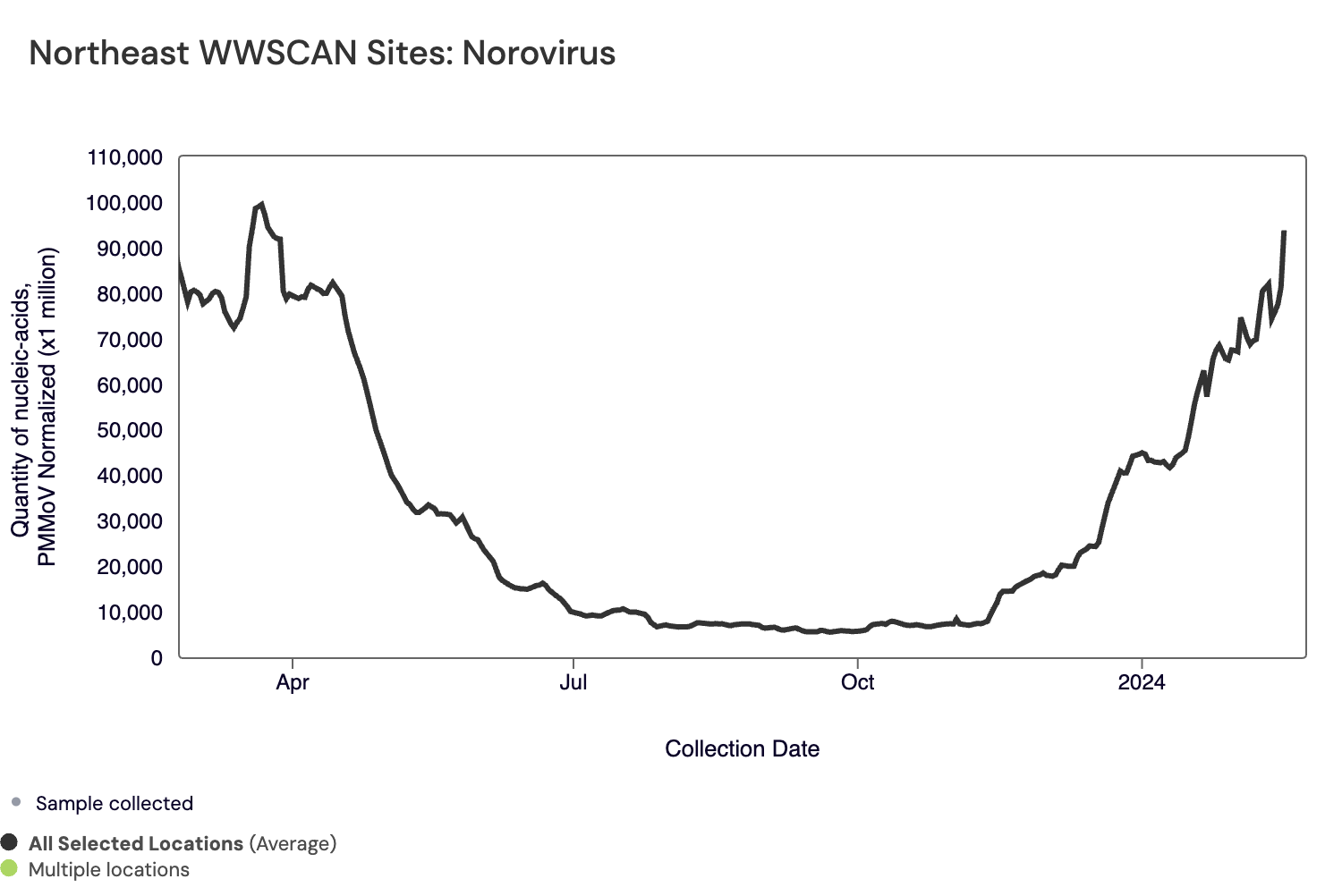
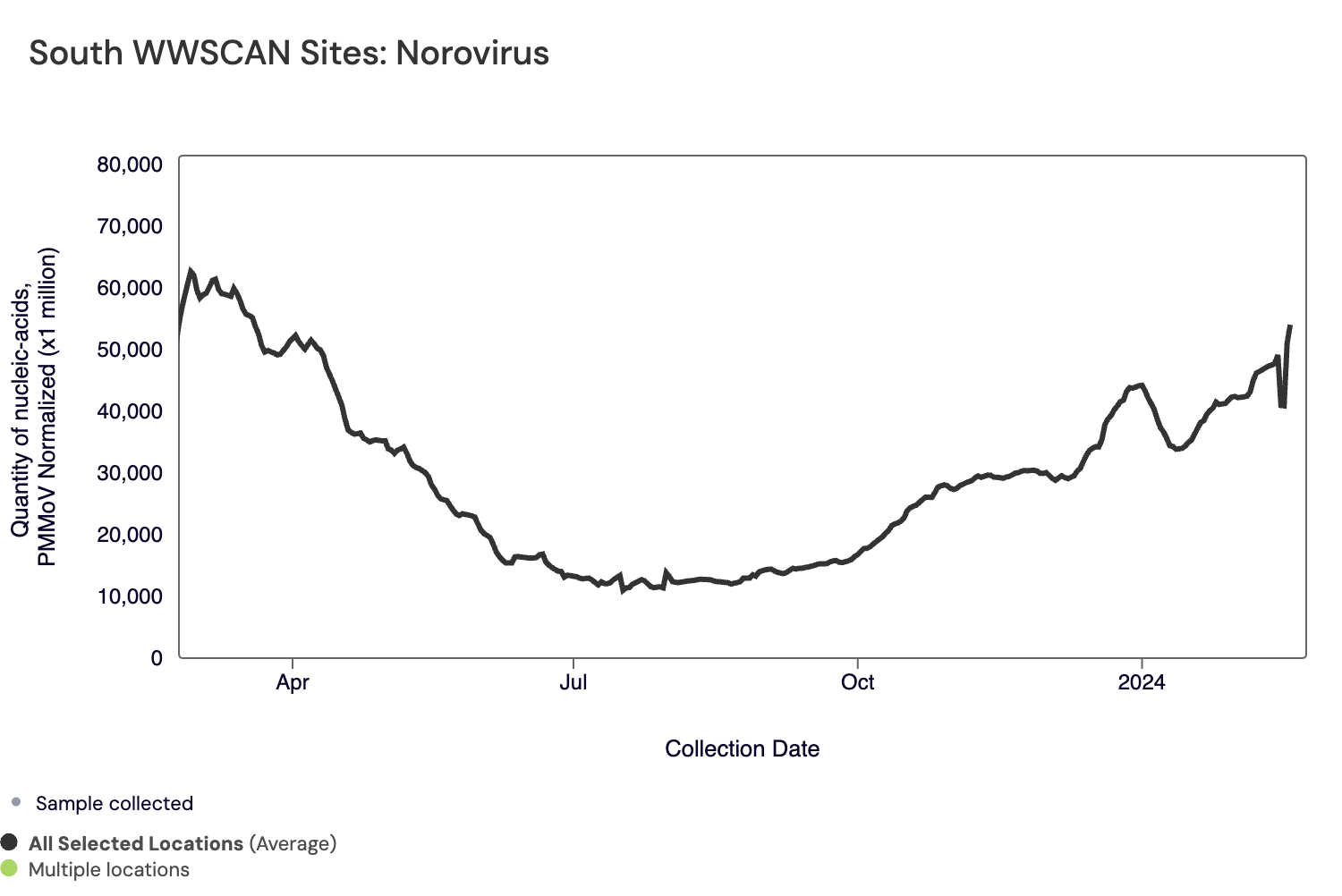
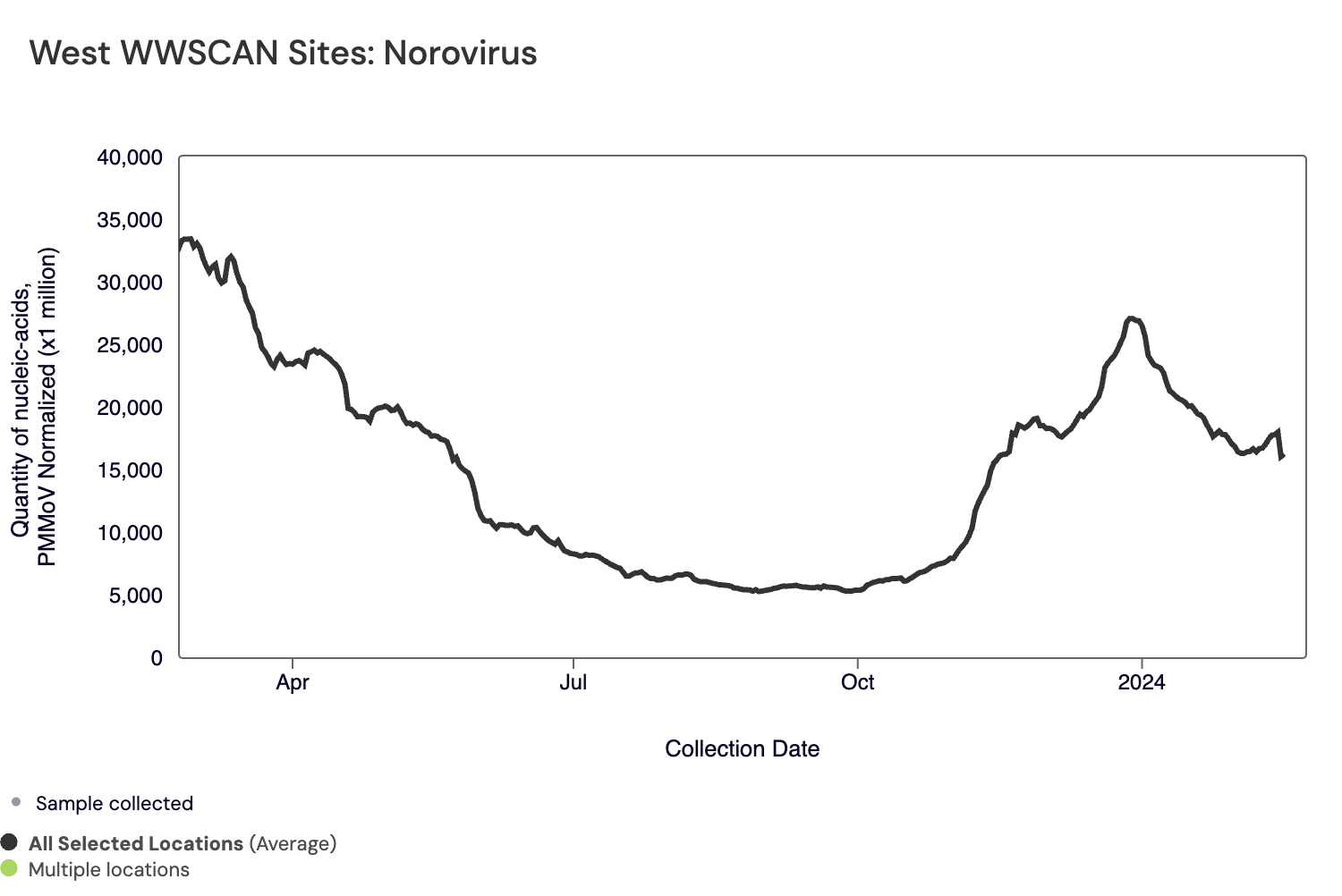
Midwest states: IA, IL, IN, KS, MI, MN, NE, OH, SD, WI. Northeast states: CT, MA, ME, NH, NJ, NY, PA, VT. Southern states: AL, AR, DE, FL, GA, KY, LA, MD, MS, NC, TN, TX, VA, WV and Washington DC. Western States: AK, CA, CO, HI, ID, NV, UT, WA.
Below are the current Norovirus wastewater categories for ALL WWSCAN sites:
- 15 are in the LOW Wastewater Category
- 42 are in the MEDIUM Wastewater Category
- 104 are in the HIGH Wastewater Category
- 30 do not have enough data to calculate (Fremont, CA; Madera, CA; Marina, CA; Newark, CA; Ontario, CA; San Rafael, CA; Santa Cruz County, CA; Santa Rosa, CA; South San Diego, CA; Union City, CA; West Railroad, San Rafael, CA; South Miami, FL; Columbus, GA; Hilo, HI; Honouliuli, HI; Sand Island, HI; Wahiawa, HI; Waianae, HI; Louisville, KY; York, ME; Millbury, MA; Jackson, MI; Gautier, MS; Pascagoula Moss Point, MS; Newark, NJ; Youngstown, OH; Chester, PA; Harrisburg, PA; Memphis, TN; Southside Dallas, TX)

Norovirus Wastewater Categories. This map includes sample collection data through February 21, 2024. Each dot represents a single site and the four US Census regions are outlined in gray. Midwest states: IA, IL, IN, KS, MI, MN, NE, OH, SD, WI. Northeast states: CT, MA, ME, NH, NJ, NY, PA, VT. Southern states: AL, AR, DE, FL, GA, KY, LA, MD, MS, NC, TN, TX, VA, WV and Washington DC. Western States: AK, CA, CO, HI, ID, NV, UT, WA.
Rotavirus RNA concentrations are shown in the chart below; all the WWSCAN plants are shown together as a population-weighted average line. Rotavirus median concentrations across all sites over the last 21 days is 160,755 copies/gram. For reference, the median concentration in January 2024 was 124,606 copies/gram. You can interact with the chart of all the plants here. Levels in early 2024 are higher than fall 2023, when monitoring began. As we collect more data, we will be better able to interpret trends and levels of this pathogen.

Other Pathogens of Concern
Mpox, Candida auris, and Hepatitis A
Mpox DNA We have only detected mpox DNA in 4 samples from all sites in the past 21 days. The chart below plants in HHS region 4 as rows, and the last 21 days as columns (labeled at the bottom axis). White indicates no samples, blue is non-detect for mpox DNA and red is detect for mpox DNA.
The wastewater categorization for Mpox at 161 sites is LOW. 30 sites did not have enough data to calculate a category.

Candida auris (C.auris) DNA - We have detected C. auris DNA in 1.3% of samples from all WWSCAN sites over the past three weeks. The chart below shows each WWSCAN plant in HHS Region 5 as rows, and the last 21 days as columns (labeled at the bottom axis). White indicates no samples, blue is non-detect for C. auris DNA and red is detect for C. auris DNA.
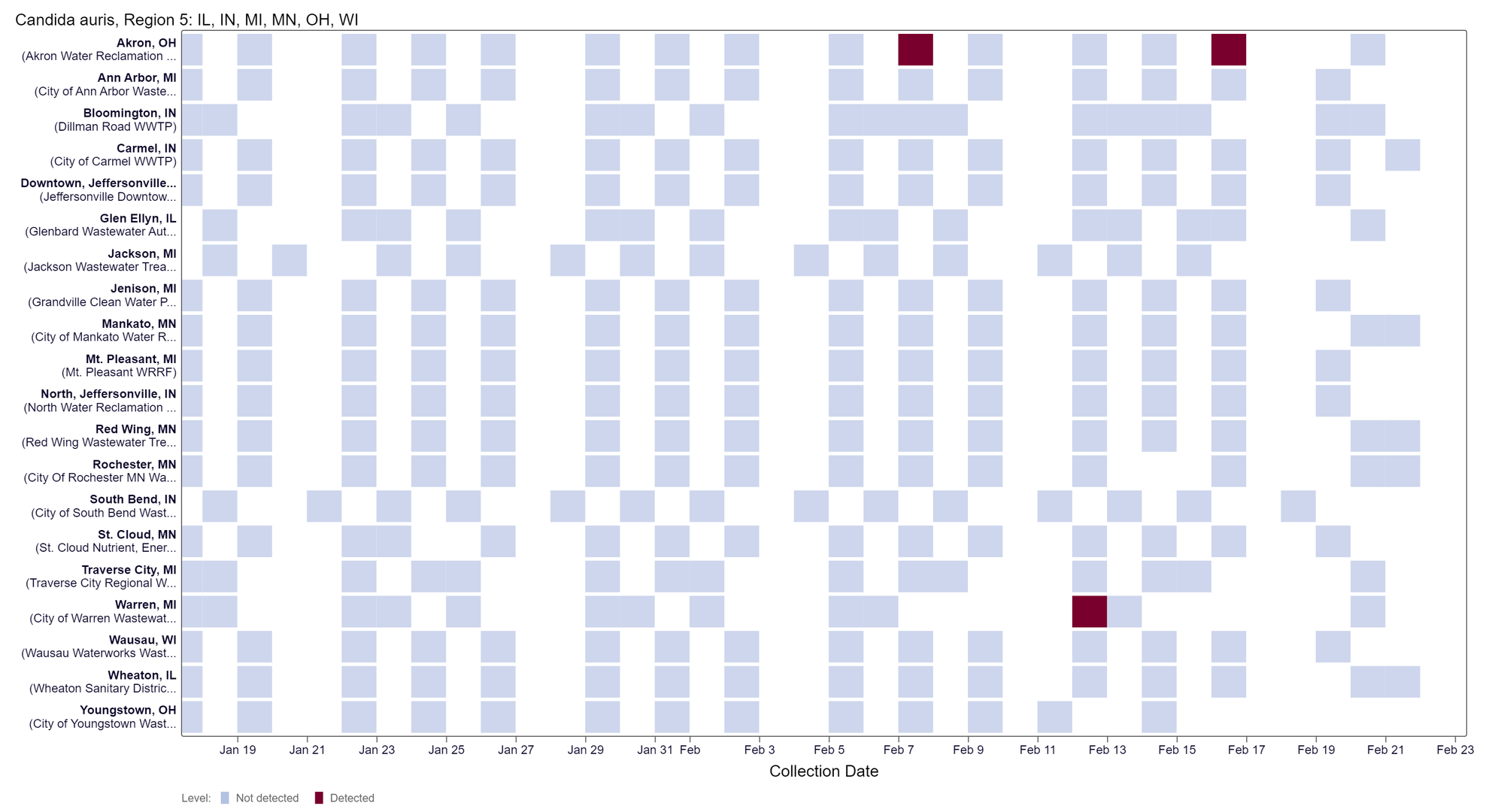
Hepatitis A (Hep A) RNA - We have detected Hep A RNA in 10.4% of samples from all WWSCAN sites over the past three weeks. The chart below shows each WWSCAN plant in HHS Region 9 as rows, and the last 21 days as columns (labeled at the bottom axis). White indicates no samples, blue is a non-detect for Hep A RNA and red is a detect for Hep A RNA.
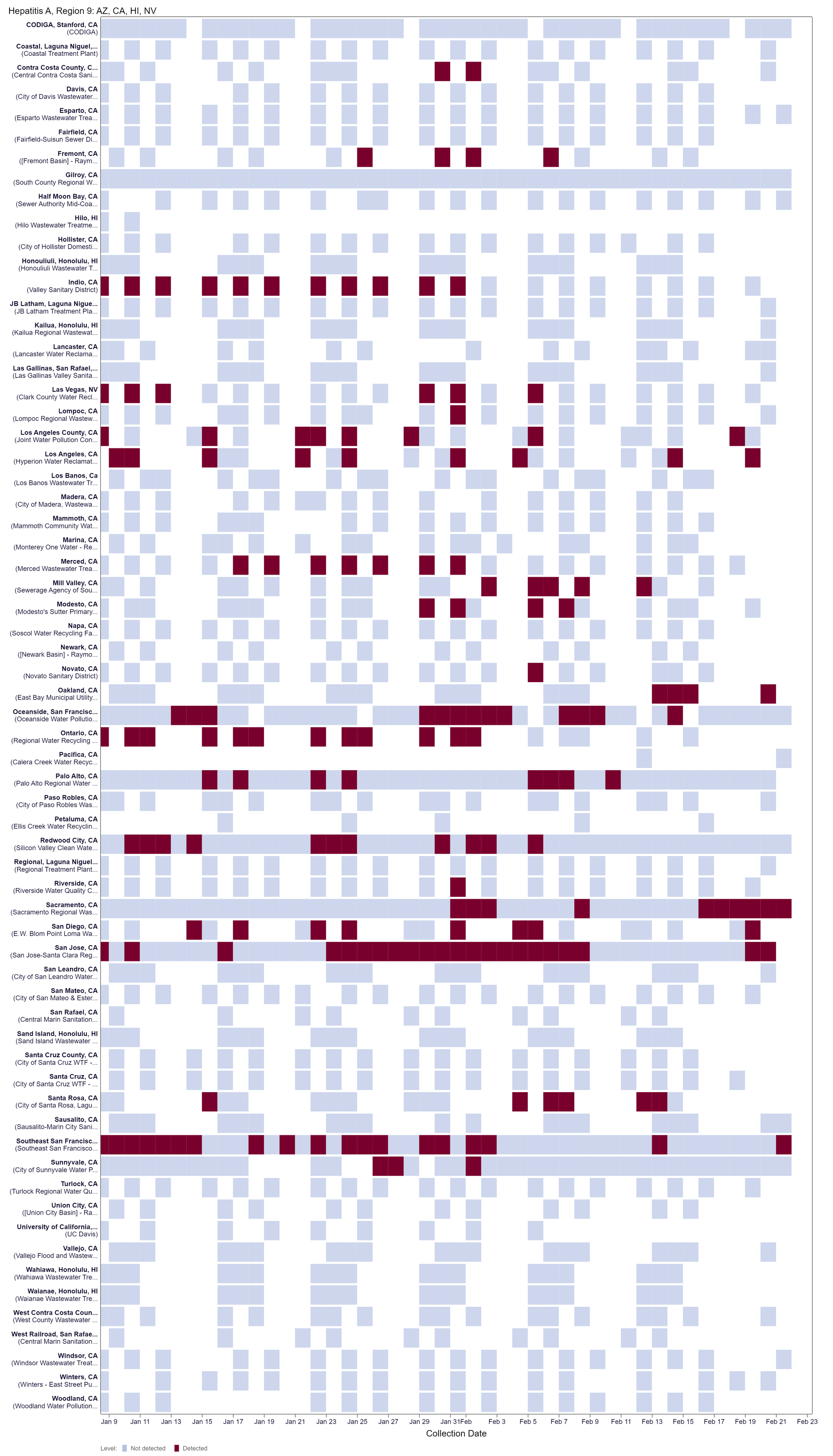
WWSCAN protocols and methods in peer reviewed publications
Protocols (Pre-analytical methods and SARS-CoV-2 analytical methods including controls):
- High Throughput RNA Extraction and PCR Inhibitor Removal of Settled Solids for Wastewater Surveillance of SARS-CoV-2 RNA
- High Throughput pre-analytical processing of wastewater settled solids for SARS-CoV-2 RNA analyses
- Quantification of SARS-CoV-2 variant mutations (HV69-70, E484K/N501Y, del156-157/R158G, del143-145, LPPA24S, S:477-505, and ORF1a Del 141-143) in settled solids using digital RT-PCR
- High Throughput SARS-COV-2, PMMoV, and BCoV quantification in settled solids using digital RT-PCR
Pre-prints and peer-reviewed publications provided WWSCAN methods:
- SARS-CoV-2
- Influenza, Human metapneumovirus, Respiratory syncytial virus, Human parainfluenza
- Mpox
- Norovirus GII
- Adenovirus group F, Rotavirus, Candida auris, Hepatitis A
- Enterovirus D68
To see find a complete list of peer-reviewed publications utilizing the WWSCAN data here.
Join us at the next WWSCAN Stakeholder call on March 8th, 2024
If you have questions about the website or anything else, please email: wwscan_stanford_emory@lists.stanford.edu
